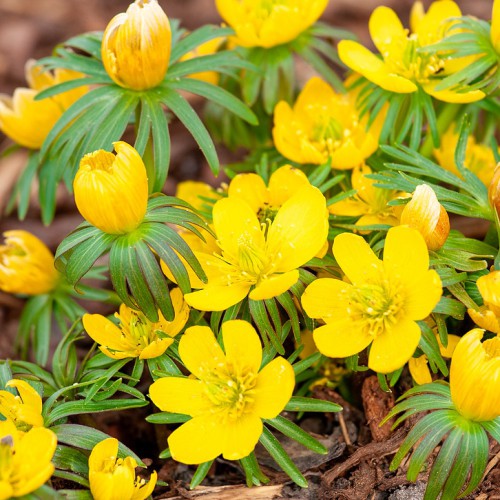
| Jan | Feb | Mar | Apr | May | Jun | Jul | Aug | Sep | Oct | Nov | Dec | |
|---|---|---|---|---|---|---|---|---|---|---|---|---|
| Planting | ||||||||||||
| Flowering | ||||||||||||
| Availability |
Eranthis Hymalis
Eranthis hyemalis, commonly known as winter aconite, is an enchanting perennial herbaceous plant hailing from the buttercup family (Ranunculaceae). This hardy flower is notable for being one of the first to bloom in the early signs of spring, often pushing its delicate foliage through a layer of snow, signifying the end of winter’s grasp.
The blooms of winter aconite are particularly striking, featuring bright yellow, cup-shaped flowers that typically measure around 1 to 2 inches in diameter. Each flower sits atop a slender stem, surrounded by a ring of glossy, dark green, leaf-like bracts that add a lush texture to their appearance. These vibrant blooms not only attract pollinators such as bees and butterflies but also stand out beautifully against the often-muted tones of late winter and early spring.
Winter aconite thrives in well-drained, rich soil and is commonly found in the dappled shade beneath deciduous trees, where it can create stunning, naturalised colonies over time. Its ability to spread through both seeds and underground tubers allows it to form dense carpets of golden flowers, transforming woodland gardens into breathtaking displays of colour.
However, it’s critical to acknowledge that winter aconite contains toxic compounds, making it dangerous if ingested. All parts of the plant can pose a risk, particularly to pets and small children, so caution is advised for those cultivating this delightful species. With proper care and respect for its potential hazards, winter aconite can be a stunning addition to early spring landscapes, offering a welcome burst of brightness as nature awakens.
| Colour | Yellow |
|---|---|
| Height | 8cm |
| Flowers | January/February |
| Planting Depth | 5cm |
| Distance Apart | 8cm |
| Bulb Size | 4/+cm |
